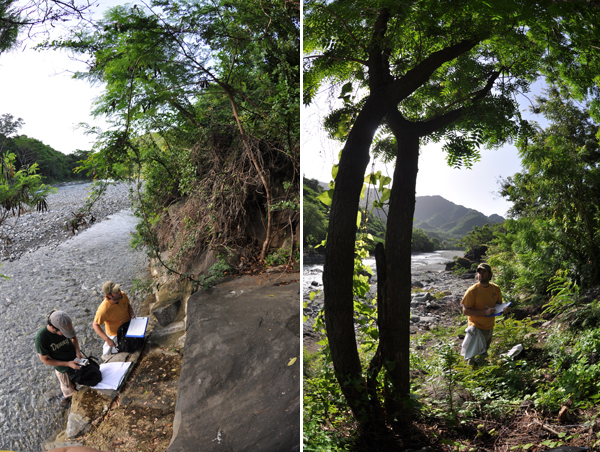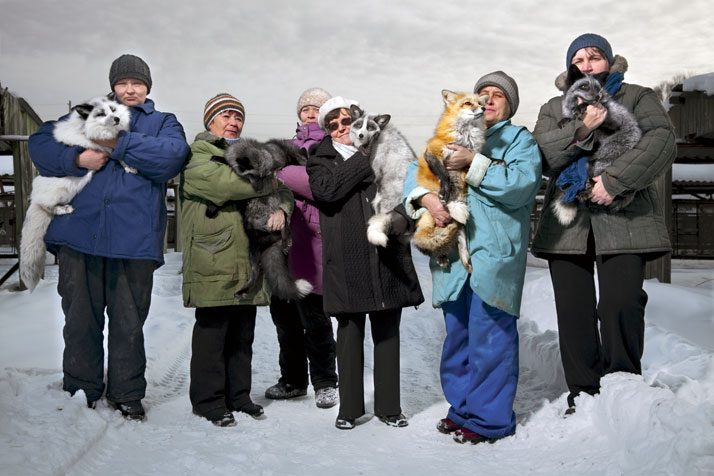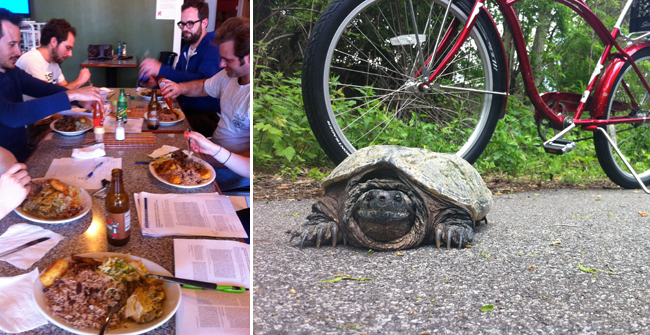 Over the past week, we introduced outgoing Glor Lab post-graduate researcher to anole research. One of Shea’s main tasks was to record light readings from perches where lizards were observed along the Rio Bani. These readings are necessary to determine if anoles with different dewlap colors and patterns tend to display in different light environments (a prerequisite for models of speciation involving sensory drive). Shea performed this task fearlessly, as illustrated by the photographs above, in which Shea can be seen taking measurements just inches from active wasp nests (nests are in white circles). Although Shea was often most directly in harms way, Anthony Geneva managed to exceed Shea’s sting total by wandering directly into a nest while searching for data loggers placed along a steep embankment. In fact, Shea’s only string of the trip came as a result of running through Anthony’s wasp cloud in an effort to catch a giant anole that Anthony disturbed from its perch during his panicked retreat.
Over the past week, we introduced outgoing Glor Lab post-graduate researcher to anole research. One of Shea’s main tasks was to record light readings from perches where lizards were observed along the Rio Bani. These readings are necessary to determine if anoles with different dewlap colors and patterns tend to display in different light environments (a prerequisite for models of speciation involving sensory drive). Shea performed this task fearlessly, as illustrated by the photographs above, in which Shea can be seen taking measurements just inches from active wasp nests (nests are in white circles). Although Shea was often most directly in harms way, Anthony Geneva managed to exceed Shea’s sting total by wandering directly into a nest while searching for data loggers placed along a steep embankment. In fact, Shea’s only string of the trip came as a result of running through Anthony’s wasp cloud in an effort to catch a giant anole that Anthony disturbed from its perch during his panicked retreat.
Author Archives: Rich Glor
Going Outside Biology
Farewell to the Colonnade
Those of you who are out of town or who don’t normally enter Hutch through the plaza on the building’s east side may not yet have noticed the recent demolition of the brick colonnade extending out from the Computer Sciences building. Aficionados of brick interpretations of Greek and Neoclassical architectural embellishments may be the only ones disappointed by the loss of a structure that has done nothing but hinder foot traffic across to Baush & Lomb and the medical campus for years.
Bikes and Biology, July 29: Cichlid Macroecology
Rochester Students Sweep SSAR Awards
 Two Rochester EEB students were recognized by the Society for the Study of Amphibians and Reptiles (SSAR) for outstanding research presentations at the Joint Meetings of Ichthyologists and Herpetologists (JMIH). Dan Scantlebury won the Henri Seibert Award in Evolution/Systematics for his presentation on “Patterns of adaptive radiation in West Indian dwarf geckos (Sphaerodactylidae: Sphaerodactylus).” Anthony Geneva’s poster on “A multi-locus molecular phylogeny of distichoid anoles” won best poster in the Evolution, Genetics, & Systematics category. Congrats to Dan and Anthony!
Two Rochester EEB students were recognized by the Society for the Study of Amphibians and Reptiles (SSAR) for outstanding research presentations at the Joint Meetings of Ichthyologists and Herpetologists (JMIH). Dan Scantlebury won the Henri Seibert Award in Evolution/Systematics for his presentation on “Patterns of adaptive radiation in West Indian dwarf geckos (Sphaerodactylidae: Sphaerodactylus).” Anthony Geneva’s poster on “A multi-locus molecular phylogeny of distichoid anoles” won best poster in the Evolution, Genetics, & Systematics category. Congrats to Dan and Anthony!
Glor Lab Posters at JMIH

Shea Lambert with his poster on the ricordii species group (top) and Anthony Geneva discussing his poster on the distichus species group with Kevin DeQueiroz and Dave Weisrock (bottom).
During yesterday afternoon’s poster session at the Joint Meeting of Ichthyologists and Herpetologists (JMIH), Glor Lab post-graduate researcher Shea Lambert and PhD student Anthony Geneva presented results from their ongoing multilocus phylogenetic analyses of Hispaniola anoles. Congratulations to Shea and Anthony for a job well done!
Miss USA Supports Evolution
I’m happy to report that the new Miss USA is “a huge science geek” who believes in the “big bang theory and, you know, the evolution of humans, you know, throughout, you know, time.”
http://www.youtube.com/watch?v=oYVkIJl5yTs&feature=player_embedded
Look, I realize that she’s no wordsmith, but she sounds like genius relative to her competitors.
http://www.youtube.com/watch?v=gofckdVB2fU&feature=player_embedded
Seminar Next Monday on Genetics of Fox Behavior
Next Monday, Dr. Anna Kukekova will be in town to discuss “Genetics of complex behaviors in the silver fox model of animal domestication.” The seminar is at noon in Hutch 473. Dr. Kukekova investigates the genetics of domestication and disease in canines (citations and links to two recent papers are below). Dr. Kukekova was also featured in a recent National Geographic article on “Taming the Wild” and is a consultant for a forthcoming NOVA special on “Dogs Decoded.”
Statham et al. (2011) On the origin of a domesticated species: identifying the parent population of Russian silver foxes (Vulpes vulpes). Biological Journal of Linnean Society 103:168-175 [doi link]
Goldstein et al. (2010) Exonic SINE insertion in STK38L causes canine early retinal degeneration (erd). Genomics 96:362-368 [doi link]
Bikes and Biology
This Thursday at 1:30PM we’ll be taking another bike expedition to a local eatery. We’ll be discussing two classic papers on community assembly.
Diamond, J. M. and M. E. Gilpin (1982) Examination of the “null” model of Connor and Simberloff for species co-occurrences on islands. Oecologia 52:64-74 [doi link]
Connor, E. F. and D. Simberloff (1979) The assembly of species communities: chance or competition? Ecology 60:1132-1140 [jstor stable URL]
PS – Last week’s outing to the Peppa Pot ended with delicious meals for all! For around $7 you can get a huge plate of Jamaican food including: meat (chicken or oxtail, rice and beans, plantain, duppling, and stewed cabbage.
Next Week’s Bike Expedition: Island Speciation in Birds
For next week’s bike expedition, we’re going to read two recent papers on speciation in island birds (links are below). I’ve also written a short commentary for Molecular Ecology on these papers that I can provide to anyone who’s interested (it’s not yet available on-line). We’ll depart from outside Hutch at 1PM on Thursday, June 2nd. Possible destinations include: Sully’s, New Taj India (Corn Hill Landing), Napa Pizza (South Wedge), Owl House, and S.E.A. (Monroe Ave.).
Melo et al. (2011) Rapid parallel evolution of aberrant traits in the diversification of the Gulf of Guinea white-eyes (Aves, Zosteropidae). Molecular Ecology [doi link]
Sly et al. (2011) Ancient islands and modern invasions: disparate phylogeographic histories among Hispaniola’s endemic birds. Molecular Ecology [doi link]






